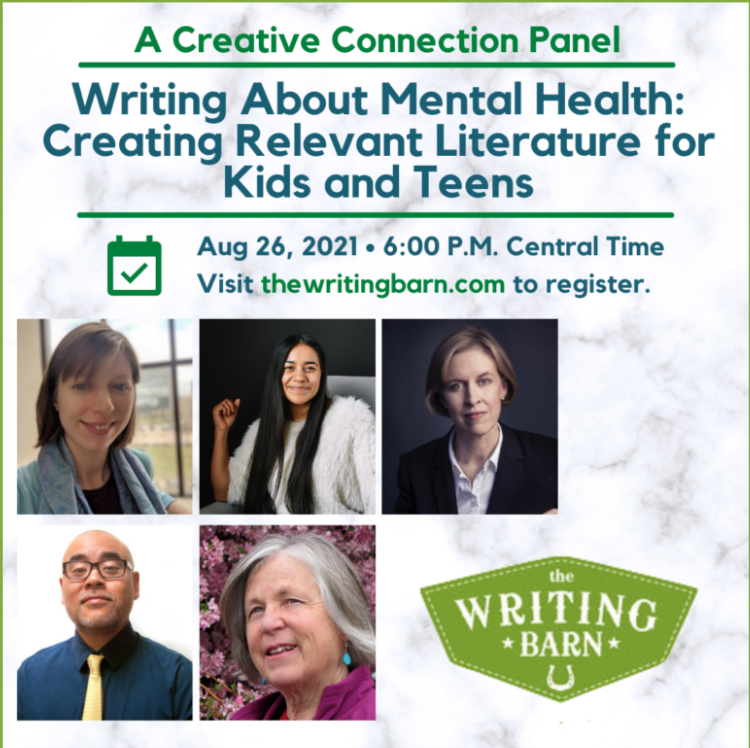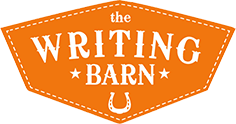At The Writing Barn, we believe deeply that the purpose of publishing is to be seen and heard, to have the tapestry of human experience communicated from writer to reader, heart to heart. It is time for deep and lasting change, and we are committed to learning, listening, and developing equitable programs and inclusive and exclusive offerings when needed.
The Writing Barn’s Creative Connections panel series was conceived with these values in mind. Our latest panel discussion, Writing About Mental Health: Creating Relevant Literature for Kids and Teens, gathered on August 26, 2021. Our panelists included authors Ari Tison, Ann Jacobus, and Dan Santat, as well as Amy Fitzgerald, Editorial Director for Carolrhoda Books. Thank you to Writing Barn Diversity Equity and Inclusion Committee member Nancy Bo Flood for moderating the panel and for sharing key takeaways below.
While this was the last of our initial run of Creative Connections panels, our DEI committee is convening again to plan more events, so keep an eye on our class listing page for future offerings! Thank you to all who have participated in this series and contributed to these critical conversations.

Mental illness touches all families. It is often invisible but is one of the most frequent disabilities affecting children—one in six at any one moment. Suicide is the second leading cause of death of teens and young adults. But mental illness remains shrouded in shame, isolation, and silence. Why?
Stigma is one key reason—the negative attitudes, prejudice, fear, guilt, or self-blame that still surround all aspects of mental illness: recognition, diagnosis, seeking help, engaging in therapy, sharing fears, and letting go of denial. Stigma, silence, and shame delay the seeking of treatment, on average, for ten to eleven years. Most teens (90%) who have died from suicide had an underlying diagnosable and often untreated mental health condition.
Books help break stigma. More than ever, well-written, sensitive books, from picture books to YA novels, are needed. A good book, a well-told story, offers the reader a “window” and a “mirror,” a realistic story about a character seeking help and eventually coping successfully with mental illness. These stories help normalize mental illness, leading to the realization that “I’m not the only one; there are many like me. It’s not my fault. Help and support are out there.” As writers and illustrators we can change the perception, and the story, about mental illness.
A huge thanks to the panelists for sharing their insights with full transparency. Topics discussed include:
- How to write stories about mental health with sensitivity and intentionality
- The urgent need for these stories and the power of narrative and representation
- Who can write these stories? Our consensus was: Whoever has the passion, an emotional connection, will do the research and seek feedback from professionals. Also, authors shouldn’t have to “prove” anything regarding their own experiences. Everyone deserves privacy, especially when it comes to sex, gender, and mental illness.
- Considerations when addressing this topic for different age groups (PB, middle grade, YA)
- Tricks, tips, and tools, like: Writing through metaphor; writing disturbing scenes “off-stage”; avoiding any type of graphic voyeurism; never romanticizing self-harm, especially suicide; and avoiding mental illness tropes and stereotypes.
Additional key take-aways from the panelists include:
- Amy Fitzgerald, Editorial Director for Carolrhoda Books at Lerner Publishing Groups, sums up her view of a good mental health story: “A balance of honesty and hope is crucial. I believe it’s the key to individual growth and societal change….young people want these books…our relevance hinges on delivering stories that tell all kinds of truths.”
- Ari Tison, debut YA novelist, discussed how to avoid creating “trauma porn,” the use of trauma and mental health as a plot device or to entice a reader. The character needs to be the “emotional hook,” not the subject of voyeurism. Ari described other tools in her author toolbox when writing about difficult material, such as humor and using memory (flashbacks) to distance potentially overwhelming emotional material while keeping possible triggering interactions off-screen.
- Dan Santat, award-winning author and illustrator, spoke openly about his use of poetic devices, especially metaphor, when creating picture books or graphic novels that deal with depression and anxiety. Take a look at his beautiful picture book After the Fall: How Humpty Dumpty Got Back Up Again.
- Ann Jacobus, YA author and long-time volunteer for the suicide crisis line, shared key points when writing about suicide and recommended this year’s Newbery Honor book Fighting Words. Ann also addressed the importance of self-care when anyone is deep into creating books about tough topics. *For more recommended books, see Ann’s website:* https://www.annjacobus.com/
- Author and moderator Nancy Bo Flood emphasized the power of books to open up possibilities for the reader, enabling a reader “to see differently.” If the story becomes too hard emotionally, the reader can close the book. The reader has the power to stop, take a break. A book that deals honestly with mental illness is also an invitation to begin a conversation about a tough subject—with a friend, a trusted adult, a parent.
We hope this is just the beginning of an ongoing conversation about mental health literature for kids and teens.
Not part of a particular #ownvoices community but want to contribute to that community regardless?
Consider donating as an ally HERE. A donation to our Diversity, Equity, and Inclusion Fund will go towards the following:
- Scholarships for BIPOC, LGBTQIA+ and Neurodiverse and Disabled writers
- Funding DEI events and panels, including the Creative Connections Panels and future events
